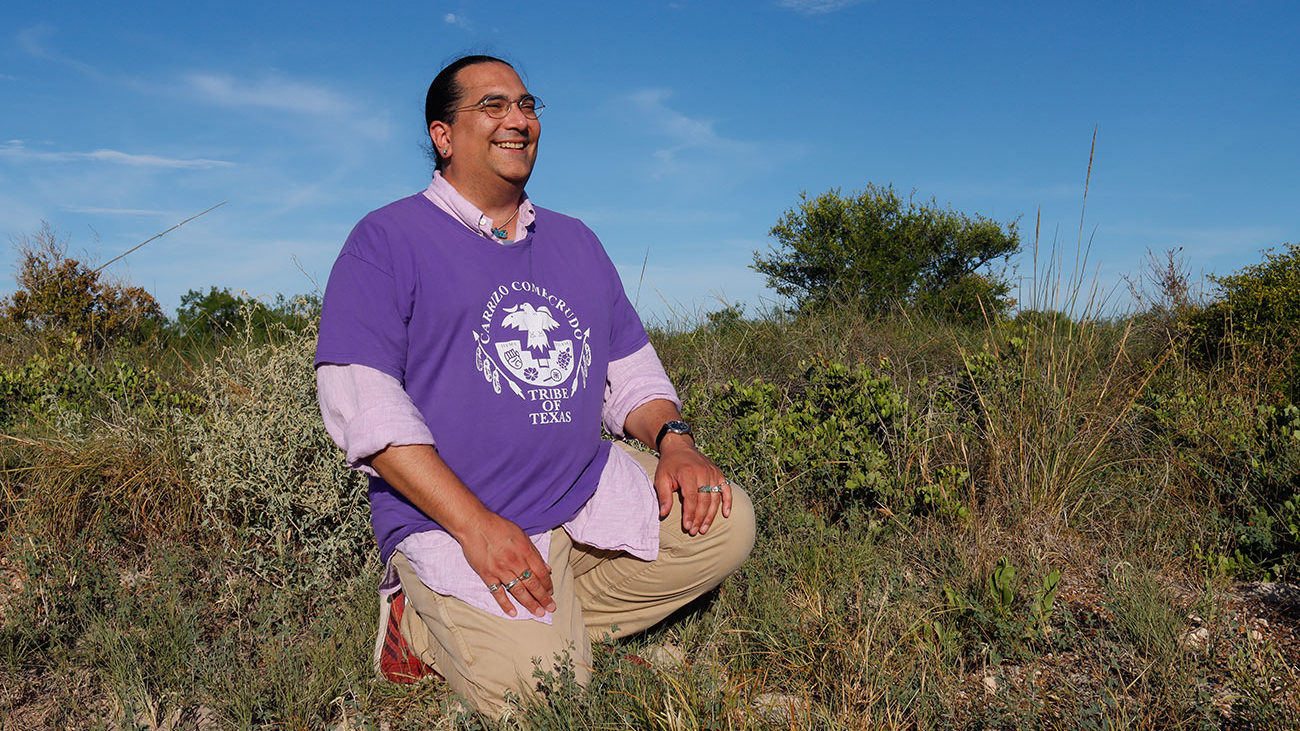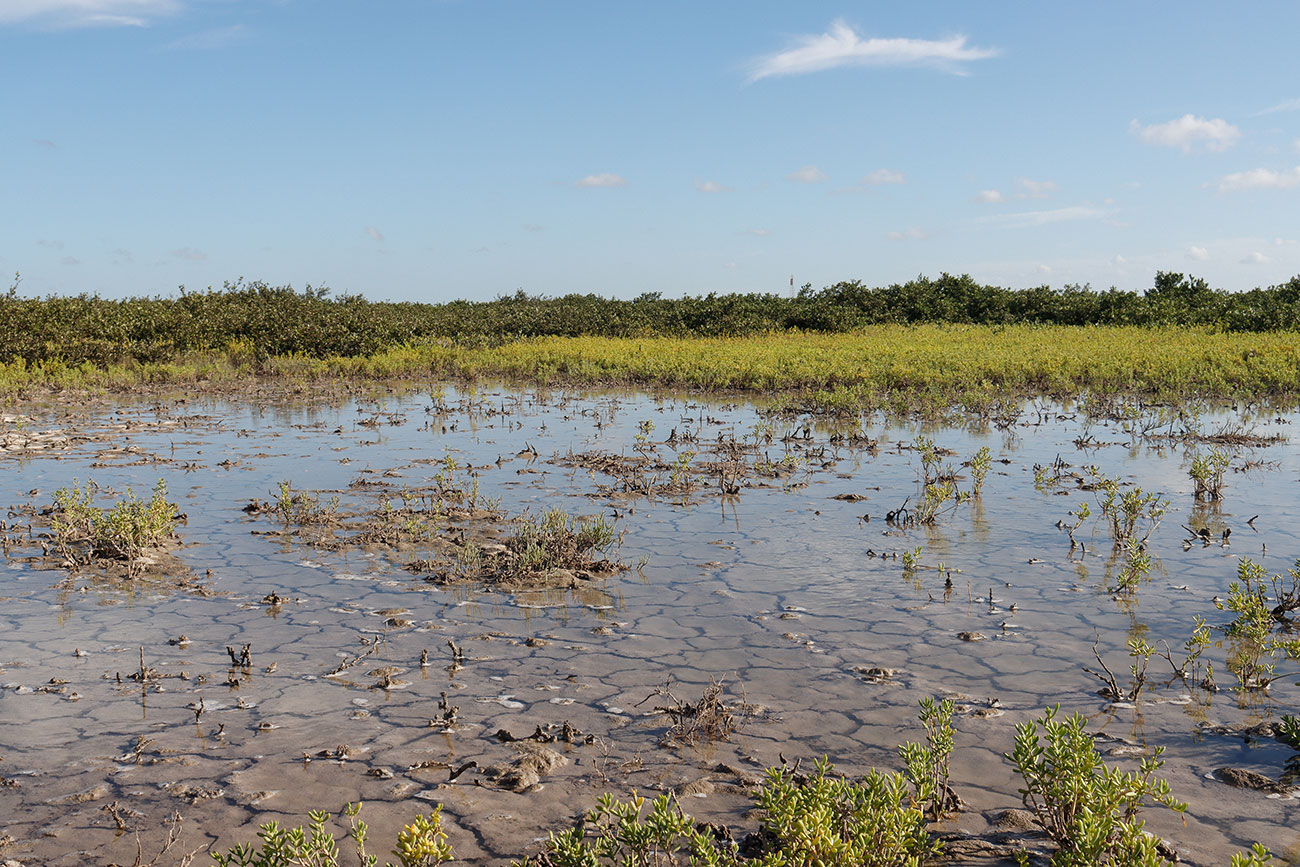Brownsville, Texas
The Threat of Fracked Gas Exports in the Rio Grande Valley
The impending development of pipelines and terminals for fracked gas along Brownsville’s shipping channel is a threat to the environment and local residents’ way of life. Based in Brownsville, Bekah Hinojosa is a campaigner with the Sierra Club’s Beyond Dirty Fuels campaign. The work of community leaders and the Sierra Club has been covered frequently in local newspapers, but we felt that the full story of their work is not well known. We asked Bekah to talk about the tactics she and her fellow organizers use and what it’s like to battle such large corporate entities, and a development that may be seen as a foregone conclusion. —Lizzie MacWillie, Kelsey Menzel, Jesse Miller, and Josué Ramirez, Brownsville Undercurrents editors

Christopher Basaldu, an Esto’k Gna (Carrizo Comecrudo Tribe of Texas) member, connects with the Garcia Pasture site. The sacred land has burial grounds and contact period artifacts of the Carrizo Comecrudo Tribe of Texas. Basaldu said, “We are fighting against three proposed terminals which are Rio Grande, Texas, and Annova LNG, because the land we are in is from my ancestors, and it is also a restored wetland for migratory birds and endangered species. Unfortunately, there is very little natural habitat left in the Rio Grande Valley and I would not like to see it destroyed.” Credit: Veronica Gaona
My family and I have deep roots in the Rio Grande Valley of South Texas. For generations, we and others like us have withstood many tropical storms and enjoyed the beach along the pristine coastline whenever we could. Today I am a campaigner with the Sierra Club, and I work with community members from the Rio Grande Valley who are on the frontlines facing three different but simultaneous threats to our region. These are the threats of flooding from superstorms and agonizing heat waves, both brought on by climate change; the militarization of the US–Mexico border, including a border wall that will irrevocably scar pristine native lands and destroy endangered species’ habitat; and the impending construction of three fracked gas export terminals that would change our community’s way of life for the worse, having negative ripple effects on communities across not only Texas but the globe.
Leaders from the Rio Grande Valley have been working together to raise awareness that these three fracked gas export terminals would be a local disaster for community wellness on many levels. The terminals—Annova LNG [liquified natural gas], Texas LNG, and Rio Grande LNG—and the associated Rio Bravo Pipeline are projects by these eponymous competing corporations. The terminals are to be built side-by-side along the Port of Brownsville ship channel. Combined, they would span almost 3,000 acres of hulking industrialization and consist of massive pipelines, smoking flare stacks, and storage tanks 19 stories tall, all serviced by tanker ships the length of 3 football fields that carry the gas out of the ship channel to overseas. Undeniably these projects would be a health hazard, releasing toxic air pollution into nearby marginalized neighborhoods and contributing to greenhouse gases in the atmosphere, thereby worsening climate change. The proposed industrial landscape brings extreme safety risks such as pipeline explosions and gas leakage that can drift for miles as flammable vapor clouds. The local economies of our Gulf Coast communities would suffer dramatically. Shrimping, fishing, ecotourism, and beach tourism, which depend on and thrive in a clean environment, could be pushed out by the presence of the fracked gas industry.

Josette Hinojosa, an environmental and political activist, looks over the Rio Grande LNG site. Hinojosa has been working against the fracked gas project for the past five years, along with concerned environmentalists and Carrizo Comecrudo Tribe members. Hinojosa said, “I wanted to be part of the movement because I have lived in places where there are refineries, and since then I’ve learned to appreciate the Valley—in particular Brownsville, because we don’t have that industry here.” Credit: Veronica Gaona
Communities at the Forefront
The communities at the mouth of the Ship Channel that are most likely to be affected by the fracked gas operations (a list that includes South Padre Island, Port Isabel, Laguna Vista, Laguna Heights, and Long Island Village) have passed resolutions to oppose the terminals. The Point Isabel Independent School District, which serves these potentially-impacted communities, has also registered its opposition by voting to reject tax cuts for Rio Grande LNG and Annova LNG.
Locals have every right to stand up to these companies because the three projects would become the biggest polluters in the Rio Grande Valley. As one of the few spots in the region with clear skies free from towering fossil fuel flare stacks and looming industrial infrastructure, families from South Texas, Northern Mexico, and further afield enjoy the Rio Grande Valley’s coastline. Annova LNG plans to build its export terminal on 600 acres of pristine wetlands and the unique Loma habitat that has been federally protected to provide habitat for endangered species like the ocelot. These habitats allow for species migration and connect to an international wildlife corridor that includes the Bahia Grande, the largest wetland restoration project in North America; the Laguna Atascosa National Wildlife Refuge; and the Lower Rio Grande Valley National Wildlife Refuge. The wildlife corridor is also home to the endangered Aplomado Falcon, the Kemps Ridley Sea Turtle, and many other vital plants and species that contribute to our community’s amazing, thriving ecosystem.
Construction of the fracked gas terminals would mean colonization of these unspoiled lands and disrespecting Indigenous people and their history and culture. To build its 600-acre facility, Texas LNG would bulldoze a federally recognized pre-Columbian site that archaeologists refer to as “Garcia Pasture.”
“[t]he proposed Texas LNG terminal site contains one of the premier prehistoric archeological sites in Cameron County, the Garcia Pasture Site. The Garcia Pasture Site (41CF8), which is listed on the National Register of Historic Places, has known burials, discrete shell working areas, and contact period artifacts.” —US National Park Service1Letter from National Park Service Re: Texas LNG, Port of Brownsville, TX, Docket No. PF15-14-000, Draft Resource Reports, United States Department of the Interior, February 5, 2016.
These lands are sacred to the Carrizo Comecrudo (Estók G’na) Tribe of Texas, the original people of the region. While there has been no archeological study in the immediate area of the proposed construction site of Rio Grande LNG and Annova LNG, patterns of archaic burials and villages in the vicinity show a need for more excavation, especially before any building permits are granted. None of the companies behind the fracked gas projects has ever consulted with the Carrizo Comecrudo Tribe of Texas about the proposed destruction to their lands.
“We ask that they stop ignoring the Native Original People of Texas’ pleas and to protect our sacred lifeways and sacred sites.” —Juan Mancias, Chairman of the Carrizo Comecrudo Tribe of Texas
False Promises from the Gas Industry
Despite the massive public opposition and the known threats to our way of life, public health, safety, and the climate, many local elected officials have repeatedly sold out and sided with these fossil fuel corporations. The Cameron County Commissioners ignored their constituents and approved a $373 million tax cut for the Rio Grande LNG project and another multimillion dollar tax cut for Annova LNG. It’s an insult for the fracked gas corporations to say they want to be a good neighbor but end up polluting air, destroying land, and negatively impacting the community’s lifeblood industries of tourism and shrimping.
Rio Grande LNG promises an unknown/undisclosed portion of permanent jobs for qualified applicants who have lived within a 100-mile radius of the terminal for a minimum of 6 months prior to employment or to someone who was born within that radius. That these requirements should count as a local hire are questionable, but the fact is that no amount of “local hires” can be used to justify the threats the industry poses to the region.
As a result of people power and the unstable oil and gas market, the Rio Grande LNG, Texas LNG, and Annova LNG projects have been facing significant delays and are years behind their target dates. Regardless, the fight isn’t over; the terminals are very close to receiving all their permits to build: Rio Grande LNG is awaiting a final investment decision (FID); Texas LNG is pending a biological review from the US Fish and Wildlife Service; and Annova LNG and Texas LNG are pending authorization from the Army Corp of Engineers. If these projects are approved, they will be undeniably destructive. Permitting is not a done deal and we cannot relent.
Creative Campaigning
For the last five years, I have been on the ground working with Rio Grande Valley leaders and have been a part of a movement for community wellness working to stop these terminals. Local residents have been working in coalition with Texas Rio Grande Legal Aid (TRLA), the Carrizo Comecrudo Tribe of Texas, the Sierra Club, and the ship channel cities to oppose the projects by challenging permit decisions made by the Federal Energy Regulatory Commission (FERC) and other federal and state regulatory agencies. Meanwhile, residents are continuing to pressure public officials to cease their support for these projects, and to speak out against tax cuts, while demanding transparency from the regulators and companies.2Sierra Club, “South Texas Communities Urge Cameron County to Reject Tax Break for Fracked Gas Terminal,” October 19, 2020. Although COVID-19 has limited face-to-face meetings, people are coming together to keep supporters informed by hosting webinars or pláticas (chats) on social media to remain up-to-date about FERC commenting deadlines.
Our creative campaigning also focuses on public outreach and awareness; urging banks such as Société Générale and Bank Macquarie to divest; and pressing every company involved with the terminals to abandon their support.
The fracked gas projects are not a done deal. Even a rubber-stamped permit approval doesn’t mean the end, and the fight is definitely not over. It remains critical that we continue our campaign to stop these fracked gas projects from being built. If built, the terminals will increase fracking in the Texas Eagle Ford Shale and the Permian Basin. This activity will contribute to the global climate crisis/catastrophe by releasing 9.2 million tons of greenhouse gases into the atmosphere per year. And, unfortunately, the same companies that are backing the project will impact communities in other parts of the world where other import and export terminals are located, where drilling will increase, where the fracked gas will be processed, and where thousands of miles of pipelines are laid. Together we can do our part to mitigate climate and ecological catastrophe so that other generations may enjoy pristine coastlines, clean environments, and community-based economies.
Biographies
is an artist and organizer from the Rio Grande Valley of Texas. She works with communities along the Texas coastline to stop crude oil export terminals, associated pipelines, and LNG fracked gas export terminals that would harm people of color and Indigenous populations. She is inspired by building art with people of all ages.
The views expressed here are those of the authors only and do not reflect the position of The Architectural League of New York.



